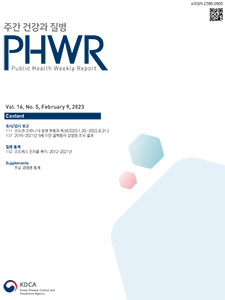Current Issue
Vol.16 No.5, February 09, 2023
-
Surveillance Reports 2023-02-09
 13
13
 2479
2479
 447
447
COVID-19 Waves and Their Characteristics in the Seoul Metropolitan Area (Jan 20, 2020–Aug 31, 2022)
Jin Ho Ha, Ji Yeon Lee, So Young Choi, Sook Kyung Park*
Public Health Weekly Report 2023; 16(5): 111-136 https://doi.org/10.56786/PHWR.2023.16.5.1 Abstract
AbstractThe SARS-CoV-2 virus, first identified in China in December 2019, spread rapidly. In January 2020, the World Health Organization officially declared a Public Health Emergency of International Concern. Due to the highly transmittable coronavirus disease 19 (COVID-19), each country has implemented various policy such as testing, quarantine contacts and social distancing. In the Republic of Korea, there have also been a large number of cases and deaths due to COVID-19. From January 20, 2020 to August 31, 2022, a total of 12,122,122 cases occurred in the capital region (52.3% of the national outbreak). The largest number of cases occurred during the 5th wave when the omicron variant spread, and the severity rate and mortality rate were the highest during 2nd wave. Until the 4th wave, the social distancing stage was applied differently depending on the situation in cities, but from the 5th wave, when the number of cases surged nationwide, it was converted to a critical patient-centered response system. Vaccines and therapeutics have been developed and has lifted recommendations for non-drug quarantine measures, but the COVID-19 pandemic is not ended yet. Efforts to overcome COVID-19 should be continued by looking back on the outbreak and response of COVID-19 and finding what has been done well and what to complement.
-
Surveillance Reports 2023-02-09
 0
0
 1963
1963
 472
472
Source Case Investigation Results for Children Under the Age of 5 Years with Tuberculosis in the Republic of Korea, 2016–2021
Jieun Kim, Yunhyung Kwon*
Public Health Weekly Report 2023; 16(5): 137-151 https://doi.org/10.56786/PHWR.2023.16.5.2AbstractChildren with tuberculosis (TB) are highly likely to be infected by recent contact with a contagious patient with TB. When a patient with TB under the age of 5 is reported, an investigation is conducted to find the TB source. From 2016 to 2021, reports of patients with TB under the age of 5 reported according to the notice of diagnostic criteria for infectious diseases, case reports, and source case investigation results were retrospectively analyzed. A total of 88 patients with TB under the age of 5 were reported between 2016 and 2021. Of these, 25 (28.4%) were infected through household contacts. Twenty-six (29.5%) cases were infected with Mycobacterium bovis Bacillus Calmette-Guérin (BCG), a vaccine strain with BCG, after vaccination, and the source of the infection was not identified in 37 (42.0%) cases. Chest X-rays were performed on 107 household contacts of children with TB and 492 contacts in congregate settings such as daycare centers and kindergartens to find the source of infection of 37 pediatric patients with TB of unknown source; however, the source cases were not found. If a young child is diagnosed with TB, the possibility of recent exposure should be suspected, and finding the source is crucial to prevent further transmission in the community. M. bovis BCG infection is an adverse reaction caused by BCG vaccination; therefore, it is necessary to confirm these cases through genotype testing and exclude these from TB reporting to accurately understand the status of patients with TB under the age of 5.
-
QuickStats 2023-02-09
 0
0
 1022
1022
 242
242
Trends in the Prevalence of Perceived Stress, 2012–2021
Public Health Weekly Report 2023; 16(5): 152-153 https://doi.org/10.56786/PHWR.2023.16.5.3

pp. 1433~1461
Most Keyword
?
What is Most Keyword?
- It is the most frequently used keyword in articles in this journal for the past two years.
Most Read
-
Waterborne and Foodborne Disease Outbreaks in the Republic of Korea, 2023
Myung-Jae Hwang, So Yeon Park, Hyungjun Kim, Se Jeong Yang, Sungchan Yang, Jin Seon Yang
Public Health Weekly Report 2025;18: 17-32 https://doi.org/10.56786/PHWR.2025.18.1.2 -
Implementation Plan for the Coronavirus Disease 2019 Vaccination for the 2024–2025 Season: Recommendations of the 6th Expert Committee on Immunization Practices
Hyewook Hwang, Wookeon Lee, Seohyeon Ahn, Young-Sook Choi, Seunghyun Lewis Kwon, Dongwoo Lee, Eun Hwa Choi, SokGoo Lee
Public Health Weekly Report 2025;18: 90-102 https://doi.org/10.56786/PHWR.2025.18.2.3
Editorial Office
+82-43-719-7569





 Full Text
Full Text Cite
Cite


